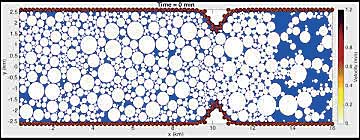07 Mar 2017 - {{hitsCtrl.values.hits}}

New computer simulations reveal the shock wave created when a chunk of ice breaks off a glacier.
This shock wave causes sea ice to shift and can even spur ‘widespread fracture,’ increasing the chances of subsequent breakage events
Understanding these processes could help scientists to better predict how melting ice will contribute to sea-level rise.
The new study from California Institute of Technology examined the effect of the ‘melange’ breakup on iceberg calving – or the process of shedding chunks of ice.
 Melange is a ‘floating aggregation of sea ice and icebergs,’ and scientists have long speculated that it may apply enough force on a glacier’s terminus to suppress calving.
Melange is a ‘floating aggregation of sea ice and icebergs,’ and scientists have long speculated that it may apply enough force on a glacier’s terminus to suppress calving.
In the winter, the icebergs that make up the melange freeze together, creating a ‘frozen iceberg logjam’ that prevents more material from breaking off.
But, as the weather gets warmer, the sea ice begins to thin, eventually allowing for the first calving event in the summer.
The new animation from Caltech reveals the effect of this process.
When the first calving event happens, it sends a shock wave through the cluster of ice.
At first, it causes compression, which later leads to slow expansion.
As a result, the event can initiate widespread breakage of the sea ice.
This reduces much of the pressure on the glacier terminus, increasing the risk of further calving.
‘Ocean and atmosphere warming in the Arctic have already caused longer periods of sea-ice-free conditions, which may lead to a transition from currently slow calving, predominantly occurring in the summer to rapid calving, occurring throughout the year.’
There is, however, also the possibility that the increased runoff from the melting ice could create a layer of cold, fresh water, spurring the formation of more sea ice.
17 Nov 2024 2 hours ago
17 Nov 2024 3 hours ago
17 Nov 2024 4 hours ago
17 Nov 2024 7 hours ago
17 Nov 2024 7 hours ago